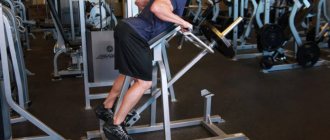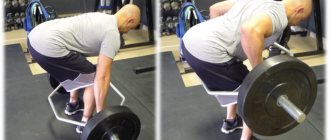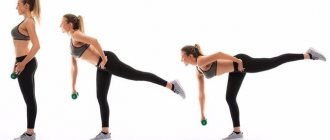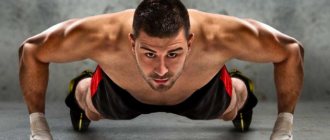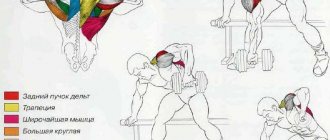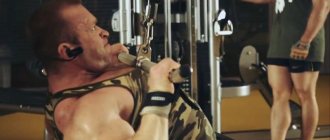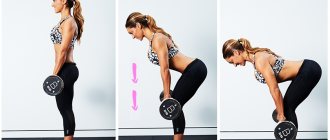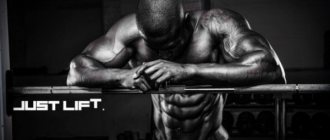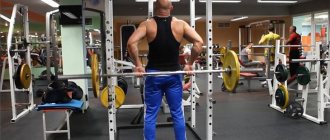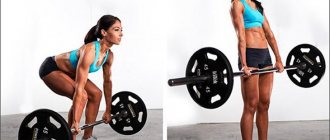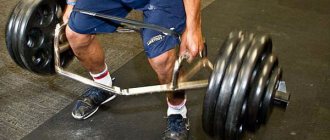Share:
Bent-over barbell rows are an exercise designed to strengthen the muscles of the upper back. It, like any other horizontal rows, mainly increases the thickness of the back, due to which the visual volume and massiveness of your torso is determined. In addition to increasing muscle mass, bent-over barbell rows help increase strength in heavy multi-joint exercises. Many experienced powerlifters consider the bent-over barbell row to be the main and main auxiliary exercise for a powerful deadlift and pay special attention to its development.
What are the benefits of doing the exercise?
Building a truly muscular torso is impossible without performing heavy, basic horizontal rows with free weights. Therefore, the benefits of standing barbell rows for increasing muscle mass are obvious. The movement vector is similar to a dumbbell row. We advise you to experimentally choose one of these exercises in which you feel maximum tension in the latissimus dorsi muscles. This will be the basis of your back training program.
By varying the grip (forward or reverse, wider than shoulder level or narrower) and the angle of the body, you can work all the back muscles with just this one exercise. Add a couple of vertical rows, deadlifts and shrugs with dumbbells or a barbell to your training complex - and this will be more than enough for a full-fledged heavy workout.
Relevance of the exercise
Many novice athletes do not pay due attention to this exercise. The reason is that they only aim to pump up the upper back in order to have a solid appearance. But this approach is completely wrong. After all, science has long proven that muscles cannot pump locally. Even if you manage to slightly grow an individual muscle, it will not look beautiful if the neighboring muscle groups remain untrained. All experienced bodybuilders believe that the body is a harmonious object in which no part should be neglected.
This exercise is very useful and effective for those who understand how important the central part of the back is. You can perform it not only with a barbell, but also with dumbbells. There is no fundamental difference, but in the case of using dumbbells, one inconvenience appears. The fact is that thanks to the barbell, the movement occurs along an even trajectory, which is difficult to create with two dumbbells, especially if the muscles are already tired. Therefore, when working with heavy weights, dumbbells are generally not suitable for this exercise. Of course, you can try to use them, but most likely, if you can achieve the correct amplitude, it will only be on the first repetitions.
Contraindications to performing deadlifts
Since sport is designed to strengthen and not undermine health, take into account the few contraindications that exist for performing bent-over barbell rows:
This exercise is not recommended for beginner athletes.
Correct and safe for the health of our musculoskeletal system, performing bent-over barbell rows requires strong spinal extensors and core muscles, which beginners can rarely boast of. First of all, it is better for them to perform lighter isolated exercises in order to strengthen all muscle groups of the body, develop a certain strength foundation, and learn to feel the contraction and stretching of a particular muscle. Only after this can you begin to perform bent-over barbell rows with a small working weight.
If you have back problems
The position of the body when performing this exercise is anatomically not entirely natural for our body, since it creates a strong axial load on the lumbar spine and increases intra-abdominal pressure. For this reason, athletes with diseases of the spine or musculoskeletal system should approach performing bent-over barbell rows with special caution.
Presence of an umbilical hernia
Also, performing this type of deadlift is contraindicated for athletes with an umbilical hernia. In this case, it is better to replace this exercise with a similar one, but with less axial load. It will be a little more difficult to achieve the desired result, but you will not aggravate existing injuries and maintain athletic longevity.
What muscles work?
Let's take a closer look at which muscle groups work when performing bent-over barbell rows. The main muscles to which the dynamic load is directed when performing the exercise are:
- latissimus dorsi muscles;
- trapezoidal;
- rhomboid muscles of the back.
Additional load is carried by the biceps, forearms, abdominal muscles, spinal extensors and posterior deltoid muscles.
Exercise options
Depending on which segment of the lats you want to focus on, bent over rows can be performed in different ways. Among the most effective and common are the following:
- straight grip barbell row;
- reverse grip barbell row;
- explosive bent-over barbell row;
- barbell row in the Smith machine;
- barbell row lying on your stomach on a bench;
- pulling the barbell to the chest.
Rows with forward and reverse grip
Bent-over barbell rows with a straight grip load the entire array of latissimus muscles and are the main tool for building a wide and sculpted back.
Bent-over barbell rows with a reverse grip place more load on the lower segment of the latissimus dorsi muscles, due to which the back muscles become more prominent and proportional. It is this variation of the bent-over row that creates that very V-shaped silhouette that the vast majority of gym goers are chasing.
Explosive bent over row
Explosive Bent Over Row – The motion vector is about the same as a regular Bent Over Row, but after each repetition we must place the barbell back on the floor and pause for one to two seconds. You can work with any grip convenient for you. This exercise perfectly develops the explosive power of all the muscles of your torso and increases your grip strength. It should be performed with moderate weight, without using an athletic belt or straps.
Smith machine row
Bent-over barbell rows on a Smith machine allow you to better focus on peak contraction of your back muscles. Due to a short pause and “squeezing” the working muscles in the upper position, the back visually becomes more lumpy and developed.
Barbell row lying on a bench
The barbell row lying on a bench is a more isolated exercise for the back muscles, representing a kind of T-bar row with emphasis on the stomach. Can be performed on both a horizontal and an inclined bench. In this exercise, there is virtually no axial load on the spine, so it can be performed by athletes who have medical contraindications to performing bent-over barbell or dumbbell rows.
Bent over row
The bent-over row of the barbell shifts most of the load to the rear deltoid muscles and the back of the trapezius, while the latissimus dorsi muscles act as a kind of assistant in the movement. It is recommended to perform this exercise with a light working weight and try to concentrate as much as possible on contracting the muscles we need. Remember that the middle and rear delts like maximum isolation work, light weights and high repetitions.
https://youtu.be/4V_9Jz018iU
Helpful Tips for Bench Rows
There are a number of common mistakes you can make in this exercise that will significantly reduce your effectiveness.
- Try not to lift your chest area away from your back during the entire approach.
- The bench row is not too demanding on weight - the rear delts, as a rule, are less developed than other areas. Therefore, you need to work here with less burden.
- Movements should be made smoothly, without jerking.
- When performing this type of deadlift, try to use only the target muscles. Otherwise, the biceps will also come into play.
The prone row allows you to work the rear deltoid area like no other exercise.
It should be included in the program of absolutely all athletes - if the shoulder muscles develop unevenly, this will not only affect their appearance, but will also slow down the development of other areas. Video Dumbbell row lying on your stomach on an incline bench
https://youtu.be/vBG0AUKuz1Q
Exercise technique
100% of your progress in sports depends on how thoroughly you follow the correct technique for performing this exercise. The fact is that pulling a barbell towards you while standing in a bent-over position is not a difficult task, but if you really want to build a powerful and strong back, pay special attention to how to do a bent-over barbell row and how to do this exercise with maximum productivity.
Let's go through the technique of performing bent-over barbell rows step by step.
Initial position
Remove the bar from the racks or lift it from the floor. It is recommended to use wrist straps. This will help put less strain on the arm muscles and better concentrate on contracting the lats. Choose your grip based on your goals. An overhand grip at shoulder-width or slightly wider targets the entire lat area, while a reverse grip that is narrower than shoulder-width works the lower lats more isolated. The lifting belt should only be used on really heavy working sets.
Selecting the torso angle
Keeping your back straight, lean back slightly to engage your spinal extensors. The stability of your position depends on the tone of the spinal extensors. Gently lean forward to the desired angle. The greater the angle of inclination, the greater the amplitude of movement, but the more difficult it is to monitor the correct position of the body. The golden mean is about 45 degrees. This way you will work in amplitude sufficient to work your back muscles, and it will be much easier to maintain balance.
Lifting the bar
Start lifting the barbell. It should be carried out slightly in an arc: at the bottom point the bar hangs approximately under the chest, at the top point we try to press it to the lower abdomen. The positive phase of the movement should be accompanied by exhalation. Perform the movement smoothly. Full mental concentration on stretching and contracting the working muscles is required. Try to work by bringing your shoulder blades together, not by bending your elbows. If you can't control the movement or feel like most of the work is being done by your biceps, reduce the weight and work, pausing at the point of peak tension. In the process of lifting the barbell, a little cheating is acceptable, but only on the condition that you keep your back perfectly straight and slightly change the angle of the body.
Lowering the bar
After a short delay at the top, lower the barbell to the starting position. As you lower, remember to take a breath and try to stretch your muscles. An important point: when you lower the barbell down, your thoracic spine should not bend down under its weight - this is fraught with injury, and no athletic belt will help you keep your body motionless. To avoid this, work with more moderate weights and additionally strengthen the spinal extensors by regularly performing hyperextensions and deadlifts.
To increase blood flow to the latissimus dorsi muscles and achieve greater pumping, try working in a static-dynamic style: do not lower the barbell all the way down, thereby maintaining constant tension in the muscles.
All of these technical principles apply to any of the above variations of this exercise. Only the load vectors and which muscle groups receive more stress change.
https://youtu.be/Wg7ZAoWhcEU
Bent-over dumbbell row technique
For athletes who want to increase the volume of their back muscles, make them sculpted and beautiful, this exercise is perfect. It is not too complicated, so it is perfect even for beginner athletes.
For women, this exercise is no less important. This technique allows you to maintain correct posture by strengthening your back muscles. Thus, a beautiful curve of the back is formed, fat deposits are removed throughout the treated area.
It is important! Beginners should avoid using heavy dumbbells in the early stages. It is also recommended to focus your attention not on the number of repetitions, but on quality, honing your technique as much as possible.
It is better for girls to perform the workout using small dumbbells. Number of repetitions - from 6 to 12, 2-3 approaches. Also suitable for women is a lighter version of the exercise, where the emphasis is not on a straight bench, but on the backrest, set at an angle of 30 degrees. The leg rests on the flat part of the projectile.
The exercise can be performed using a bench
Depending on the chosen elbow position, the muscle group involved in the workout will also change. With the elbows spread wide apart, the main load is placed on the deltoid muscles. The closer the elbows are to the body, the more the latissimus muscles are loaded.
In order for the exercise to bring the greatest results, during its implementation you should avoid the most common mistakes:
- Use too much weight;
- Raise your hand with a dumbbell with a jerk;
- Pull dumbbells towards the chest, not towards the waist;
- Incorrect back position.
One hand on the bench
The foot of the left foot is on the floor, the right leg is bent at the knee and rests on the bench. It is better to place the dumbbell on a bench so that after taking the correct position you can easily pick it up in your hand without having to change your body position.
Having bent at the waist so that a 90-degree angle is formed between your back and hips, you need to lean your right hand on the bench. The head and neck are located in line with the back, the eyes look at the floor. The left hand with the dumbbell is lowered down.
Raise the projectile held in your hand to your belt, trying to bring your elbow to the same level as your shoulder. The elbow is perpendicular to the floor. At the highest point, hold your hand for a second.
Technique for performing the exercise with one hand on a bench
Next, slowly return the hand with the projectile to its original position.
It is important! The downward movement should be controlled and smooth. Sharp, jerky movements are unacceptable.
At the lowest point, you should hold your hand for one to two seconds to stretch the working muscle as much as possible.
The upward movement of the arm occurs while exhaling, returning to the starting position while inhaling.
During the exercise, you should pay attention to the position of the opposite shoulder. It should be on the same level as the worker. If, while moving your right arm up, your left shoulder moves down, the effectiveness of the exercise will be significantly reduced.
It is also important to monitor the position of your back. If you can’t keep it level, it’s better to do the exercise on an incline bench.
Video: features of the exercise for girls
https://youtu.be/lQLhllz-lcc
Bent over with both hands alternately
This exercise can be performed in two ways:
- With a lunge;
- No lunge.
When performing the first option, put your right leg forward, transferring your body weight to it. The right elbow rests on the knee. Take the dumbbell in your left hand and, as you exhale, lift it to the waist. As you inhale, lower your hand to the starting position.
Exercise with one leg lunge forward
For the second option, a lunge is not required. The legs are slightly apart and slightly bent at the knees. The right hand is placed behind the back, placing the back of the hand in the lumbar region.
The left hand with a dumbbell is pulled to the lower back. Having fixed the elbow at the highest point, hold it for a couple of seconds, after which they return to the starting position.
It is important! It is necessary to carefully monitor the position of your back during execution. The back should be fixed and the spine straight. Otherwise, there is a high risk of injury during training.
The same exercise is often performed with both hands at the same time. However, alternating traction is more effective, as it allows you to individually select the load for each side.
Performing the exercise with both hands at the same time
This method of execution is more suitable for experienced athletes. It requires good stretching and practiced technique.
Useful tips
The list below contains several useful recommendations that will help you learn to feel your muscles much better, work with heavy weights, and protect yourself from injury by performing the bent-over barbell row exercise.
- Control the position of your elbows while lifting the barbell. At the point of peak load they should be located above the level of the housing. This way, the latissimus dorsi muscles will receive the maximum amount of stimulation to grow.
- Maintain natural lordosis in the lumbar spine throughout the entire approach. Try to statically strain the extensors of the spine - when pulling the barbell to the belt, they serve as a kind of “airbag” that protects you from unwanted injuries.
- When performing bent-over barbell rows, always keep your knees slightly bent. This will take the stress off your hamstrings and hamstrings.
- Do not change the position of your neck or the direction of your gaze during the approach. If you start looking not in front of you, but at your feet, your lumbar spine will immediately become rounded.
- Do not twist your wrists when lifting the barbell. This reduces the range of motion and shifts the lion's share of the load to the muscles of the forearms.
- To alternate the load on different parts of the back muscles, change the angle of the torso and the grip width of the barbell.
Preparation and starting position
Raise a bench off the floor or place a board covered with soft material on the power frame stops. The bench or board should be at such a height that you, lying face down on it, could barely reach the weight on the floor. You can adjust the distance between the bench and the weight by placing a weight plate of the desired thickness under each end of the barbell or under each dumbbell.
When working with a barbell, you can grab it with either a direct or reverse grip, depending on what is more convenient for you. Try a shoulder-width grip to begin with, then you can go a little wider or a little narrower. However, you may find that you are uncomfortable doing exercises with either a forward or reverse grip.
In addition to grip difficulties, the bench row has other disadvantages. Firstly, the chest is compressed and breathing becomes difficult. This is inherent in any bench row and you can get used to it, especially if you place the weight on the floor for a short time between repetitions.
Another disadvantage - especially for athletes with short arms and large chests - is the reduced range of motion due to the fact that the bar rests on the bench before the shoulder blades are fully pressed together. The thicker the bench, the shorter the amplitude. This drawback can be corrected by attaching a pair of weight handles to the barbell.
If you take dumbbells instead of a barbell, you will be able to do the exercise with greater amplitude and a more comfortable grip. Dumbbells allow you to keep your hands in a natural parallel or nearly parallel position. However, the dumbbell plates, depending on their diameter, may interfere with the movement through the full amplitude - you will be forced to move your arms to the sides so as not to hit the bench with the dumbbells. You can try to solve this problem by putting small-diameter weight plates on the dumbbells and using a parallel grip instead of a pronated one.
Starting position for dumbbell rows lying down. With your forearms perpendicular to the floor, pull the dumbbells as high as possible.
Perhaps there is a better way (it was suggested in the chapter on dumbbell bent-over rows) - try attaching a kettlebell handle to each dumbbell, or use a pair of montini dumbbell bars without locks.
With their help, you will be able to do the exercise with full amplitude at the top, without resorting to small-diameter weight plates, and the weight plates will not rest against the bench.
Bent-over barbell row: what to replace?
Some athletes are contraindicated from performing bent-over barbell rows for one physiological reason or another. However, this does not at all put an end to their goal of increasing the size of the back muscles, since there are many other exercises with similar biomechanics.
Check out the exercises listed below. Try a few of them during your next back workout to see which ones give you a better feel for how the load is placed on the working muscles. All of these exercises are horizontal rows. They are performed in block or lever machines, and in them it is enough to simply feel the contraction of the latissimus dorsi muscles.
T-bar row with emphasis on the stomach
The T-bar row with emphasis on the stomach is almost similar to the classic bent-over barbell row. It is performed on a specialized simulator. The athlete lies stomach down on a surface inclined at an angle of 30-45 degrees, grabs the handles of the apparatus and performs an upward traction movement, directing the shoulder blades towards each other and trying to raise the elbows above the level of the body. Can be performed with either a wide or narrow grip. Typically, T-bar row machines have a lever design and simulate working with free weights, which makes the movement even more effective. What is better to choose for an athlete who does not have injuries or problems with the spine - T-bar rows or bent-over barbell rows? It makes sense to do both of these exercises. They complement each other perfectly and place a heavy and complex load on the entire array of back muscles.
Horizontal row in a lever machine
Horizontal rows in a lever machine are a rather technically complex exercise for working the latissimus dorsi muscles. You can work with one hand or two hands at the same time, using different handles. The only problem is that not every gym is equipped with a truly well-designed horizontal rowing machine; most of them are absolutely not suitable for working out the back - the rear deltoids, biceps or trapezius muscles are loaded more.
Horizontal pull on the lower block
Horizontal row on the lower block is an isolated exercise for working various parts of the muscles of the upper back. Its main advantage is that, due to the block design of the simulator, the load does not leave the muscles throughout the entire approach, and they remain tense even at the point of maximum stretching. This exercise can be done using a variety of handles, from a narrow parallel grip to a wide straight grip. By varying the handles, you can work the latissimus dorsi muscles over their entire surface without doing a lot of work. It is advisable to work in the most strict technique, without helping yourself with your body.
Rowing
Rowing is a more functional exercise than all of the above, but also well suited for our purpose. The fact is that when working on a machine that simulates rowing, we perform a movement similar to a horizontal row from the lower block with a narrow parallel grip. Try to concentrate more on the latissimus dorsi muscles while pulling the handle towards you, and you will pump blood into your muscles perfectly, simultaneously developing your endurance and coordination.
Narrow parallel grip pull-ups
Pull-ups with a narrow parallel grip are perhaps the only vertical row that works more on the thickness than the width of the back. It is most convenient to perform it using a narrow handle from a block exercise machine, hanging it over the crossbar. This exercise should be performed with the maximum possible amplitude. Try to reach the handle with the bottom of your chest - the load will be placed exclusively on the bottom of the lats. You can perform a similar movement on the upper block using a narrow handle, but technically it will be much more difficult.
Pullover from the top block
Pullover from the top block is a combined exercise that combines elements of loading on the width and thickness of the back. It develops the thickness of the back well, since in the upper half of the amplitude we fully stretch the latissimus dorsi muscles, and in the lower half we contract and “push” them as much as possible. This style of work significantly increases blood flow into the muscle, which has a beneficial effect on its volume and strength. It is recommended to use a rope handle.
Nuances
It is important not to lift your chest off the bench. Otherwise, emphasis is lost, and the load on other parts of the body increases. This leads to injury and makes the technique less effective.
It is also important to understand that the load on the chest should not be extreme. Otherwise, injury may also occur. In order not to overload the chest, it is better to avoid the maximum weight.
To perform the exercise correctly, it is important to keep your elbows close to your body. In this situation, the shoulder muscles work less. If it is difficult to hold sports equipment in your hands, you can use straps. If in this case the technique is difficult, it is better to stop the exercise and do something easier. Then, when the body is ready, it is possible to return to the method.
There are variations of the technique. There are two of them. In one case, the same thing is done, but the bench is located horizontally to the floor. In such a situation, there is a chance to better work the rhomboid muscles on the back. However, to do this you will have to squeeze your shoulder blades together.
However, this option will not be feasible for everyone. Unlike incline rows, the load shifts upward because the body position is horizontal. The back muscles work poorly, because the amplitude is shortened.
Another option is a reverse grip. The difference with the classic method is that the biceps play a big role. The amplitude is greater. It is more convenient to lift the barbell from the floor. There is no fundamental difference. If during such an exercise your hands suddenly become sore, this is an alarming sign, and you should consult a doctor and stop training for a while.
If the instructor says that in all respects a person is ready for such a deadlift, but there is pain, discomfort, or simply cannot be performed, this is a reason to worry. Perhaps the fact is that some kind of injury occurred that went unnoticed. It's worth seeing a doctor.
What can be replaced
This method is a basic method, so it can easily be replaced with other exercises. However, if your health and fitness permit, you should not bypass the lying row, because the technique has proven itself to be excellent.
If for some reason this is not suitable, here is what to replace this craving with:
- Bent-over barbell row.
- Push-ups on parallel bars with the body tilted forward. The grip is wide.
- Pull a dumbbell to the stomach with one hand, resting with the other. The person stands at an angle.
- For the latissimus dorsi muscle - traction of vertical and horizontal blocks.
Like bench rows, these exercises require the person to already be fairly prepared. If you had to do office work for twenty years and had no energy left for gymnastics, you can’t start with these kinds of methods.
To begin with, it is worth tidying up the muscles of the whole body, strengthening them and making sure that the cardiovascular system is strong enough and healthy.
If a person suffered an illness, even many years ago, it is better to take this circumstance into account. Some diseases, in principle, are not conducive to heavy physical activity.
That is why in such a situation it is better to consult a doctor first. Then there will be no complications from this or any other technique associated with efforts that are not typical for a person in everyday life.
https://youtu.be/3mKqEVzK_fo
